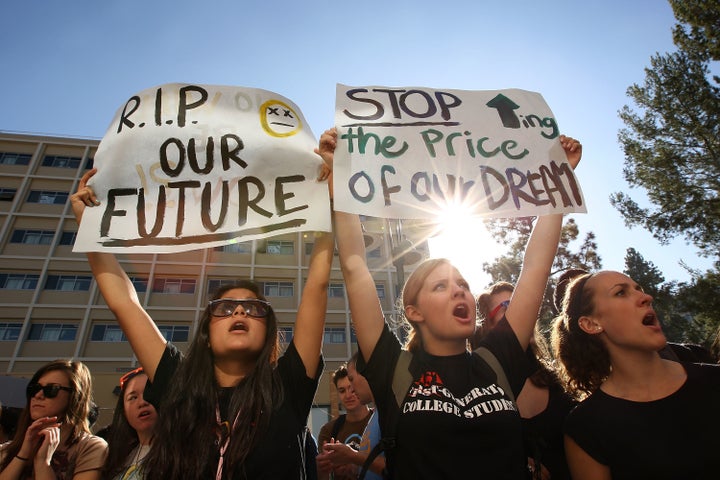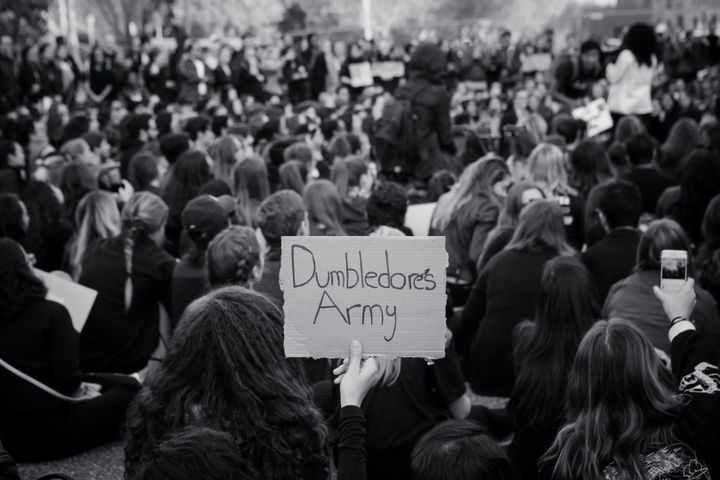This year, the number of international students at U.S. colleges and universities topped a million for the first time ever. Chinese students studying here made up almost a third of that total. The vast majority of these students pay full tuition straight out of family coffers, effectively subsidizing local students who benefit from in-state discounts. These international students have become a lifesaver for public colleges in an era of dramatic cuts to funding for higher education.
But all of that could become threatened if President-elect Donald Trump goes forward with his campaign promise of a trade war with China. He famously called for a 45 percent tariff on Chinese goods ― an act that would virtually guarantee retaliation from Beijing.
Cutting Chinese enrollment at U.S. schools would be one of Beijing’s stronger weapons in an otherwise limited arsenal. Higher education is one of the few sectors in which the U.S. boasts a substantial trade surplus with (i.e. depends heavily on) China. While Beijing has few direct ways of stopping students from studying abroad, Chinese officials have many indirect levers for manipulating these flows.
International students have been a lifesaver for public colleges in an era of dramatic funding cuts.
Public universities across the U.S. ― from Humboldt State University to the University of Michigan ― have formed partnerships with Chinese institutions that act as funnels for studying in the U.S. Those programs could be dissolved with the stroke of a bureaucrat’s pen. China’s Ministry of Education could easily crack down on the vast number of “international schools,” special bilingual high school curricula designed as a runway for students planning to study abroad (a move that local officials in Shanghai initiated even before the election). More hardline forms of retaliation could extend to cutting off currency transfers or even withholding passports from students.
But beyond any specific policies, Trump’s own statements appear likely to slow or reverse growth in international students more broadly. Students in countries such as India, the second-largest feeder country and the fastest growing, are already reconsidering plans to study in the U.S. due to fears of racism and Islamophobia. Saudi Arabia, the third-ranked feeder country, could see an even steeper fall. While Chinese people were not themselves a direct target of Trump’s rhetoric (“I love China!”), racial tensions surrounding the election were enough for the Chinese consulate in San Francisco to issue a warning and offer a hotline for Chinese nationals victimized by racist attacks.
Despite Trump’s claim that he “loves the poorly educated,” public higher education is one slice of the economy that America can’t afford to sacrifice. America’s public colleges are both a vital part of many small-town economies and one of the last bastions of economic mobility for the working class. The New York Times’ annual College Access Index declared the University of California system to be an “upward mobility machine,” consistently fostering opportunity for students from poor families.
The problem is that massive state budget cuts mean that the “upward mobility machine” is constantly low on fuel. States have been decreasing funding for public universities for decades, but since the 2008 economic crisis, that defunding has gone into overdrive. Between 2008 and 2016, per-student state funding for higher education has fallen in 47 of 50 states. States such as Illinois and Arizona have seen per-student funding cut by more than half.
Public universities are ‘upward mobility machines.’ But they’re constantly low on fuel.
Cuts in California have been more gradual but no less devastating. Since 1999, total state funding for the University of California system has fallen by 30 percent while enrollment has grown by almost 100,000 and an entirely new campus was added to the grid. Not coincidentally, over that same period, the number of Chinese undergrads at the University of Illinois at Urbana-Champaign has multiplied by a factor of 12, from 257 to 3,115.
Last year, Chinese students alone infused $11 billion into the U.S. economy, over a third of the $30 billion that international students contributed. Industry analysts estimate that international students support over 400,000 jobs in the U.S, with almost half of these in blue collar sectors such as retail, restaurants and accommodation.
Public university presidents are caught between a rock and a hard place: tuition hikes lead to protests by students, while the flood of international students has sparked fears that admission is being auctioned to the highest bidder. An audit by California claimed that local students were hurt by the infusion of outside students into the University of California system, and that the UCs didn’t sufficiently expand enrollment for disadvantaged minorities for whom public universities may be their only option. In exchange for increased funding, this year the UC system capped international enrollment and increased local enrollment by 15 percent, including large gains for underrepresented groups.
That complex balancing act ― ensuring that expanded international enrollment supports local students ― is one best carried out at a local level. Instead, Trump’s proposed policies threaten to cut off this last resort source of funding for American higher education.
 David McNew via Getty Images
David McNew via Getty ImagesIt’s far from clear whether President Trump will in fact follow through on his pledge to punish China for its trade policies, which he compared to “rape.” He has said that he wants the U.S. to retain talented international graduates from U.S. universities. (In the same interview, Trump’s senior counselor Steve Bannon decried the presence of too many Asian CEOs in Silicon Valley.)
A trade war with China likely won’t bring jobs back to America’s rustbelt towns. More and more jobs are being automated by machines, and multinational corporations are already chasing cheaper wages outside of China, such as in Jakarta or Mumbai. But trade frictions with China could have very real consequences in some unexpected places, from Madison, Wisconsin to Austin, Texas.




